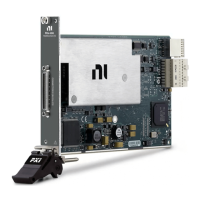7-10 | ni.com
Chapter 7 Counters
For information about connecting counter signals, refer to the
Default Counter/Timer Pins
section.
Pulse versus Semi-Period Measurements
In hardware, pulse measurement and semi-period are the same measurement. Both measure the
high and low times of a pulse. The functional difference between the two measurements is how
the data is returned. In a semi-period measurement, each high or low time is considered one point
of data and returned in units of seconds or ticks. In a pulse measurement, each pair of high and
low times is considered one point of data and returned as a paired sample in units of frequency
and duty cycle, high and low time or high and low ticks. When reading data, 10 points in a
semi-period measurement gets an array of five high times and five low times. When you read
10 points in a pulse measurement, you get an array of 10 pairs of high and low times.
Also, pulse measurements support sample clock timing while semi-period measurements do not.
Semi-Period Measurement
In semi-period measurements, the counter measures a semi-period on its Gate input signal after
the counter is armed. A semi-period is the time between any two consecutive edges on the Gate
input.
You can route an internal or external periodic clock signal (with a known period) to the Source
input of the counter. The counter counts the number of rising (or falling) edges occurring on the
Source input between two edges of the Gate signal.
You can calculate the semi-period of the Gate input by multiplying the period of the Source
signal by the number of edges returned by the counter.
Refer to the following sections for more information about X Series semi-period measurement
options:
•
Single Semi-Period Measurement
•
Implicit Buffered Semi-Period Measurement
Refer to the Pulse versus Semi-Period Measurements section for information about the
differences between semi-period measurement and pulse measurement.

